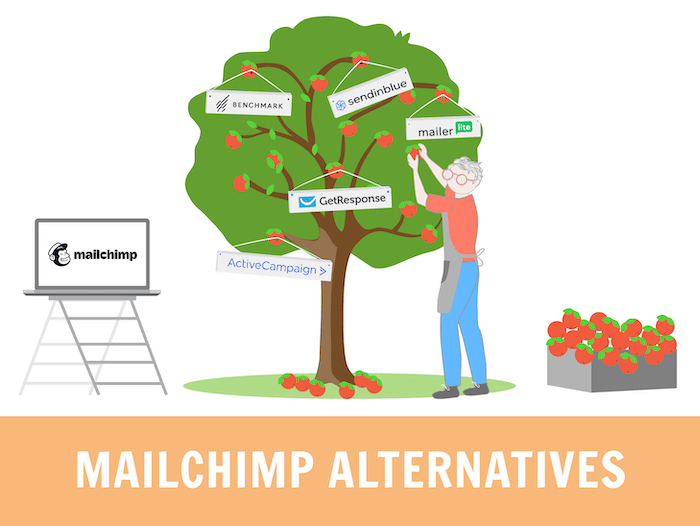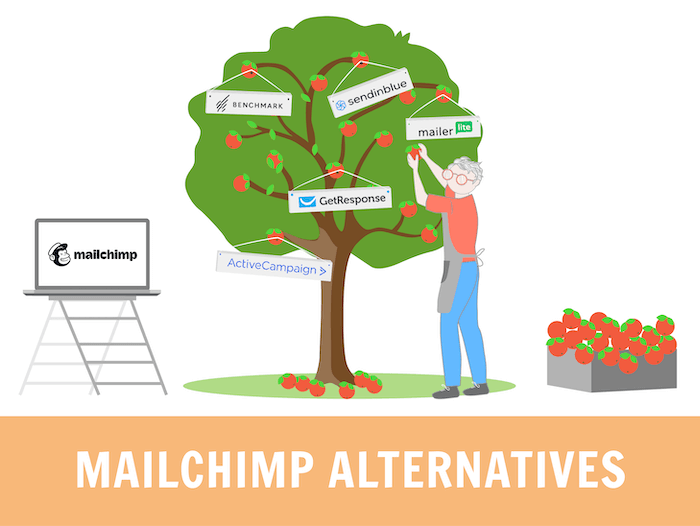
There was once a time when Mailchimp was the first name that came to mind when you thought about email marketing services. The marketing platform was a breath of fresh air within the email marketing industry, with its affordable pricing model and ease of use a big hit with small-to-medium businesses, bloggers, online store owners, and other smaller-scale users.
But with the slightly confusing changes to their pricing model back in early 2019, coupled with Mailchimp’s shock decision to stop offering a direct integration with Shopify, more and more users are seeking Mailchimp alternatives.
So if you’re one of those users, or would simply like to understand what other comparable tools are out there, read on to find out which Mailchimp alternative is right for you.
Try out ActiveCampaign, MailerLite, GetResponse, Sendinblue, Omnisend, Moosend
Smart Finder: Find the Best Mailchimp Alternative in 1 Minute
| MAILCHIMP PROS | MAILCHIMP CONS |
|
|
Table of Contents
An Overview of The Top Mailchimp Competitors
| Email Marketing Service | Ease of use | Price | Features |
|---|---|---|---|

Mailchimp Full review |
Very easy. The email builder is perfect for beginners and the paid email templates look good. | Paid plans start at $30.99 per month | Great for reports and amazing for ecommerce integration. Not so good for list segmentation, and paid plans get pricey quickly. |

MailerLite Full review |
Excellent email builder – fast and logical. Good support too. | Free plan available
Paid plans start at $17 per month Try for free |
They offer email marketing automation, a landing page builder and reporting – not as powerful as other solutions, but available for free and/or much cheaper. |
Sendinblue Full review |
Easy to navigate software that guides you through the production flow. | Free version available
Paid plans start at $25 per month Try for free |
Pretty good marketing automation and contact management. Very affordable prices. Reporting and analytics aren’t as good as Mailchimp’s. |

Moosend Full review |
Fairly straightforward to use. Live chat support available within the drag and drop email builder. | Free version available
Paid plans start at $24/mo per month Try for free |
Pretty good allowances on their free plan. Very affordable pay-as-you-go-plan. Email deliverability isn’t as good as Mailchimp’s. |
GetResponse Full review |
Very easy to use. Their knowledge base is a bit confusing though. | Free version available
Paid plans start at $19 per month Try for free |
Powerful marketing automation workflows and list management. Interesting extras such as a mobile app, landing page builder and webinar creator. Not so good for analytics and reports. |
ActiveCampaign Full review |
Fairly easy. Even if it seems more overwhelming, the support and wizards are very good. | From $15 per month
Try for free |
Very powerful sales and marketing automation. A/B tests, timed automations, CRM, landing page editor and much more. Good contact management. The reporting is good, but not as powerful as Mailchimp’s. |
Omnisend Full review |
Their interface is simple, and they have a fresh and speedy email builder that’s similar to MailChimp’s. | Free version available
Paid plans start at $16 per month Try for free |
Marketing automations specific to ecommerce – web tracking, abandoned cart, order confirmations, etc. Plus, some cool interactive features like scratch cards and gift boxes for maximizing conversions. |
 EngageBay EngageBay |
The interface is well-designed, making it a very easy-to-use tool. | Free version available
Paid plans start from $12.99/month Try for free |
Generous free plan and affordable paid plans. Excellent email marketing software and CRM features. |

Zoho |
Pretty easy to use. Live chat support available within the email builder. | Free version available
Paid plans start at $5 per month Try for free |
Generous free plan. Advanced email marketing automation and segmentation. |

Hubspot |
Very easy to navigate. Users can create content such as landing pages, emails, and forms with a drag-and-drop builder. | Free version available
Paid plans start from $50 Try for free |
They offer free email marketing and CRM software with unlimited users. Customer support is available. Access to omnichannel marketing once upgraded. Basic templates on offer. |

Mailjet Full review |
Setting up email newsletters and contact lists is easy to do! | Free version available
Paid plans start at $15 per month Try for free |
Affordable prices and excellent email deliverability. Good choice for transactional emails. Basic marketing automation. |
ConvertKit Full review |
Automations are easier to use than average. Other features, like creating forms, can be overcomplicated. | Free version available
Paid plans start at $15 per month Try for free |
Good automations and list segmentation functionalities. Newsletter and landing page design and reporting should be improved. |

Benchmark Full review |
Very good email builder and outstanding support. | Free version available
Paid plans start at $15 per month Try for free |
Good for multi-languages. Not great for marketing automation, and the file storage charges are an extra worry. Poor deliverability. |
AWeber Full review |
Some sections are a little hidden, and you’ll need to make sure you’re in the right email list at all times. Their terminology could be confusing for experienced users. | Free version available
Paid plans start at $19.99 per month Try for free |
Very good support and list and subscriber management features. Sales tracking available for your site. |
The Best Mailchimp Alternatives
After all our tests we believe that the following are the best Mailchimp competitors. Keep scrolling for a detailed breakdown.
- MailerLite – Same quality but cheaper
- Sendinblue – Better email automation and cheaper
- Moosend – Generous on features and emails
- GetResponse – More features
- ActiveCampaign – Better marketing automation
- Omnisend – Ideal for ecommerce
- EngageBay – Excellent CRM features
- Zoho – Myriad of automations
- Hubspot – All-in-one CRM platform
- Mailjet – Excellent deliverability
- ConvertKit – Better targeting
- Benchmark – Multilingual teams
- AWeber – Better support
MailerLite
Another excellent alternative to Mailchimp is MailerLite. This relatively young Lithuanian email marketing service prides itself on its modern and sleek aesthetic – and it shows. They also offer good multilingual options as well as a decent “Free Forever” plan. If you’re looking for awesome email and landing page designs, MailerLite really shines in this area (templates not available on free plan).
Where MailerLite beats Mailchimp:
The free plan, which is limited to 1,000 subscribers, includes a number of features including a landing page editor that, in our opinion, is better than Mailchimp’s. MailerLite’s paid plans are also significantly cheaper, making them a great choice for small businesses on a tight marketing budget. If you want to work in your native tongue, they offer 5 languages. They also have an app for iOS, and a website builder. It is a great free Mailchimp competitor.
> See how the marketing tools compare in our MailerLite vs Mailchimp guide.
Where Mailchimp wins:
MailerLite falls short when it comes to its reporting and tracking tools (no geo or social tracking), which makes it less than ideal for optimizing your campaigns. Mailchimp does a better job in this area.
Try MailerLite for free
Sendinblue
Those looking for a Mailchimp alternative would be wise to check out Sendinblue. A relatively new player on the email newsletter scene, Sendinblue is a Paris-based company who have decided to make waves by offering some of the cheapest plans available. And they’re also surprisingly good when it comes to marketing automation workflows and list management, plus they can be used to send transactional emails and SMS marketing. Check out our detailed Sendinblue vs MailChimp comparison to find out more about why Sendinblue is a great MailChimp alternative.
Where Sendinblue beats Mailchimp:
Sendinblue is cheaper than MailChimp. Their automation workflows system is a little more advanced, allowing you to A/B test a number of components. EU-based customers will love the fact that their servers are located in France. You can also send SMS at a very reasonable price – a feature not available with Mailchimp. Transactional emails are their strong suit, consistently performing well in our email deliverability tests.
> See how the email marketing tools compare in our Sendinblue vs Mailchimp guide.
Where Mailchimp wins:
Mailchimp is still more intuitive and easier to use for beginners, and the Sendinblue system can be a little slow. Mailchimp’s email builder also beats Sendinblue’s, and not many companies can beat their social media tracking for accurate reports.
Try Sendinblue for free
Moosend
Another Mailchimp alternative is Moosend. They caught our eye for their generous Free Forever plan, which includes access to almost all their pro features. They also include a good selection of responsive email templates and advanced segmentation. Like Mailchimp, you can pay as you go, but Moosend will cost you significantly less.
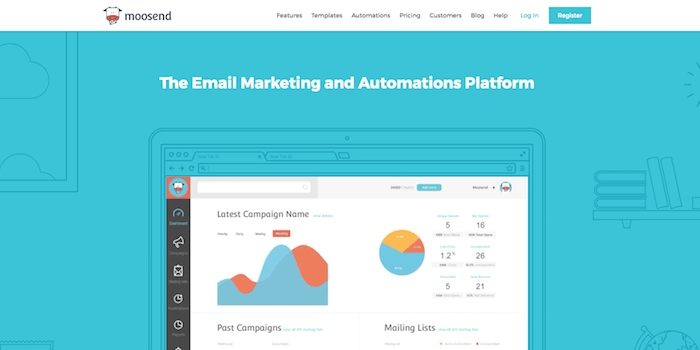
Where Moosend beats Mailchimp:
Though Moosend’s free plan limits you to 1,000 subscribers, you can send unlimited emails and it allows you access to their visually appealing marketing automation workflow editor. All emails are add-free and you’ll find their paid plans to be pretty affordable – at $64/month for 10,000 subscribers they are significantly cheaper than Mailchimp. Charging just $0.001 per email on their pay-as-you-go plan, you’ll pay a fraction of what you would on Mailchimp’s equivalent plan. Advanced segmentation is available in the free plan and landing pages are unlocked once you move up to a paid plan.
Where Mailchimp wins:
Moosend’s deliverability could do with some improvement, and we would recommend keeping a close eye on campaign performance rates. When it comes to native integrations, Mailchimp offers a bit more than Moosend.
Try Moosend for free!
GetResponse
Also a very good solution when it comes to marketing automation, GetResponse offers a wide range of unique pro features such as a landing page creator and a webinar tool. They also claim to be one of the easiest email newsletter tools available, and give you loads of extra tidbits like access to free iStock photo images and an iOS and Android app to send your campaigns on the go. But would we say they’re better than Mailchimp?
Where GetResponse beats Mailchimp:
What makes Getresponse a worthy alternative to Mailchimp? Email marketing automation is very powerful, letting you trigger sale conditions, A/B tests and removal conditions, amongst other things. You can easily move subscribers between lists. If you’re an international team, you will appreciate the 25 languages available in the interface. If you want the ability to create webinars, you’ll find it hard to do it with many platforms other than GetResponse. The Conversion funnel feature is unique to GetResponse, which facilitates setting up sales funnels. Find out more about their sales funnel software here. Their multimedia center, which lets you access stock photos and generate QR codes, amongst others, is also a nice extra.
> See how the marketing tools compare in our GetResponse vs Mailchimp guide.
Where Mailchimp wins:
GetResponse’s analytics isn’t as powerful as Mailchimp’s, as it lacks heatmaps. Features such as contact tagging and abandoned cart emails are reserved for the more expensive Plus plan, whereas Mailchimp offers these features on their free plan. In fact, GetResponse’s free plan is very limited compared to Mailchimp’s (500 subscribers vs Mailchimp’s 2,000). Additionally, GetResponse limits the number of files (e.g. images) that you can store in their media center to 1 GB, while Mailchimp doesn’t. Check out our GetResponse vs Mailchimp guide for more information.
Try GetResponse for free
ActiveCampaign
This self-described “all-in-one marketing platform” is focused on letting you reach your email marketing goals with fewer emails. To that end, ActiveCampaign offer one of the best marketing automation features we’ve ever tested, making them a great alternative to Mailchimp. You can easily create very complex sequences of emails and add a huge number of parameters such as “wait x number of days before sending”, “split test between two messages” and much more. The fact that all plans come with unlimited emails is pretty attractive, too. But would we say they’re better than Mailchimp? Read on to find out.
Where ActiveCampaign beats Mailchimp:
In terms of email sequences automation, ActiveCampaign is unbeatable. Whether you want to tag users based on behavior, run A/B tests or create complex timed automations, they have you covered. Their CRM system is robust, and they are often launching interesting features such as live chat for your website, and “site messages”, which lets you create personalized content on your website/landing pages when users arrive there from your emails. List management, which Mailchimp isn’t great at, is also a strong suit, as you can set up complex segmentation automations. Finally, they also end up cheaper than Mailchimp, and the customer support is excellent. Find out more about ActiveCamapign’s landing pages here.
> See how the email marketing tools compare in our ActiveCampaign vs Mailchimp guide.
> You might also want to check out our ActiveCampaign vs GetResponse guide.
Where Mailchimp wins:
ActiveCampaign doesn’t offer a free plan. Mailchimp’s drag and drop email builder is smoother and their ecommerce tracking is more robust (ActiveCampaign offers purchase tracking only for Shopify, BigCommerce and WooCommerce). Note that their integration with WooCommerce is only available to users on the Plus plan (from $70) and above, whereas Mailchimp offer this integration for free.
Try ActiveCampaign for free
Omnisend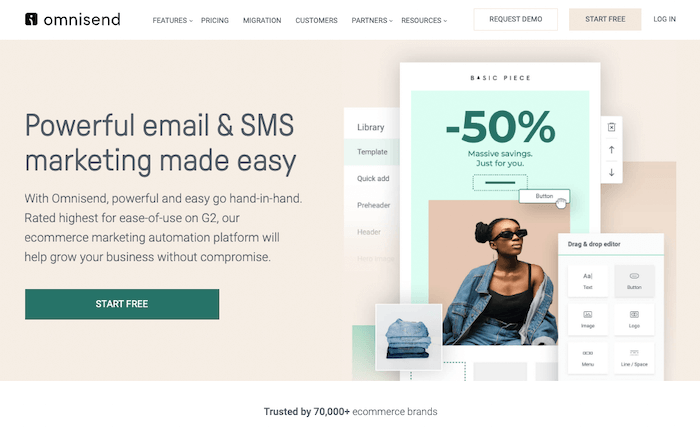
Another great Mailchimp alternative is Omnisend. This is an email and SMS platform with a strong slant toward ecommerce – something that shines through in their conversion-focused automation and segmentation options. And while MailChimp does a decent job of ecommerce, there are some clever little extras that we think give Omnisend the one up here.
Omnisend integrates really well with Shopify. You can also use it with the following ecommerce platforms: BigCommerce, WooCommerce, Volusion, PrestaShop and Magento.
Where Omnisend beats Mailchimp:
Like MailChimp, Omnisend offers stacks of automations for online stores, including browse abandonment and cart recovery (these are editable through visual workflows). But it goes a step further with unique features like ‘wheel of fortune’ incentives for sign-ups, interactive gift boxes, automated product recommendations, and even ‘live view’ website tracking – all of which are designed to boost conversions. You can also segment your email lists based on very granular data, including customers who purchased a specific product or used a discount code. Another point in Omnisend’s favor: it also includes some very modern landing page templates, and SMS marketing is included for free.
> See how the email marketing tools compare in our Omnisend vs Mailchimp guide.
Where Mailchimp wins:
Outside of ecommerce, MailChimp is probably the more versatile tool, offering more options for email templates and automation. MailChimp also includes a higher sending allowance on its free plan.
Try Omnisend for free
EngageBay
Although a relatively new product in the marketing automation niche, EngageBay has quickly grown in popularity as one of the most affordable all-in-one CRM software.
EngageBay is a great Mailchimp alternative due to the myriad of tools for email marketing, email and workflow automation, customer service management and social media management. To our surprise, EngageBay’s free plan is loaded with features that other platforms offer only with paid plans, which gives us good reason to see just how it compares against Mailchimp.
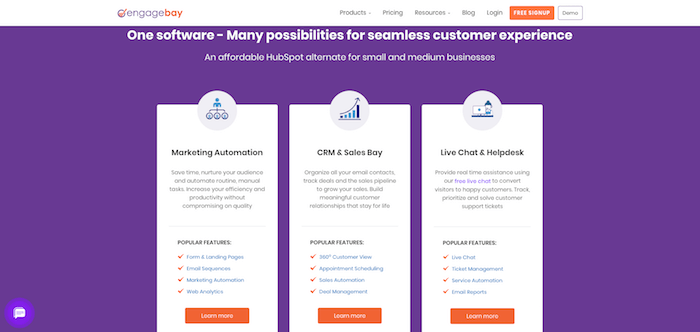
Where EngageBay beats Mailchimp:
Mailchimp gets pretty expensive fast.
Their sliding scale pricing structure can look affordable at first. But as your contacts start growing, so will the price you pay.
For example, EngageBay’s Marketing Bay offers 30,000 contacts at $49.99.
To get the same number of contacts on Mailchimp, you have to pay a crazy $219! If you want all the pro features, you have to purchase the Premium plan. The cost? A whopping $499 a month!
What’s more, Mailchimp doesn’t even reward its loyal customers by applying a discount to yearly plans, whereas EngageBay offers a 20% discount on annual subscriptions and a 40% discount on biennial subscriptions. This brings the already affordable costs even further down.
Plus, EngageBay’s free plan comes with email and chat support, which a lack of is a real disadvantage to using Mailchimp.
In terms of the CRM features, you’ll have a separate dashboard for marketing, sales and service, which keeps everything manageable. You’ll also have an area for ‘deals’, which is great for small businesses who want to keep everything under one roof. Mailchimp doesn’t offer pipeline management or much in the way of CRM features.
If you need a robust and affordable all-in-one marketing tool, then we’d recommend EngageBay.
Where Mailchimp wins:
Mailchimp has a dedicated desktop application for both Windows and Mac. It offers search marketing (SEO and PPC with Facebook, Google and Instagram), which EngageBay doesn’t.
You can also set up single-step automations with Mailchimp’s free plan, whereas EngageBay reserves marketing automation workflows for those who sign up to the Growth plan (which starts at $24.99/month).
Try EngageBay for free
Zoho Campaigns
Zoho offers an impressive suite of services, which of course includes email marketing. Considering how much ground they cover and the fact that they offer a free plan makes them a great Mailchimp alternative.
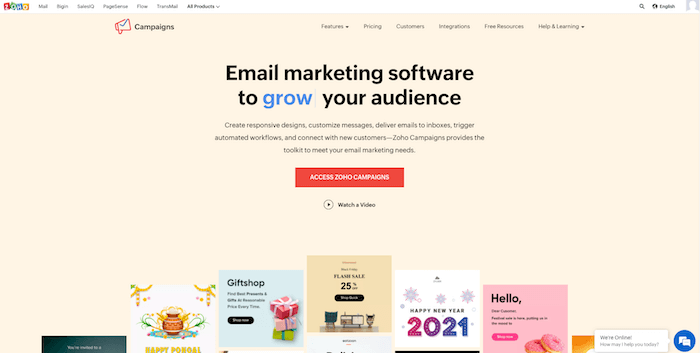
Where Zoho beats Mailchimp:
A cool feature from Zoho is that you can upload images from Unsplash directly in the email builder. We also liked their range of email and form templates.
Zoho excels in the area of automation; they offer workflows for nurturing, ecommerce, re-engagement, etc. What’s more, because Zoho comes with powerful CRM software, you can set up workflows to help you move leads through your sales funnel.
List segmentation is a simple affair, with plenty of segmentation options.
Where Mailchimp wins:
Though Zoho has a fair amount, Mailchimp still beats them when it comes to native integrations. Mailchimp is still a slightly more intuitive marketing platform for beginners.
Try Zoho Campaigns for free!
HubSpot
Branded as an all-in-one CRM platform, HubSpot is a powerful alternative to Mailchimp for both sales and marketing teams. With such an extensive number of features spread across 5 ‘hubs’, HubSpot helps businesses grow with their crafted marketing, sales, and customer service solutions. The 5 hubs are available through the paid version; offering 5 stand-alone products; Marketing Hub, Sales Hub, Service Hub, Operations Hub, and CMS Hub.
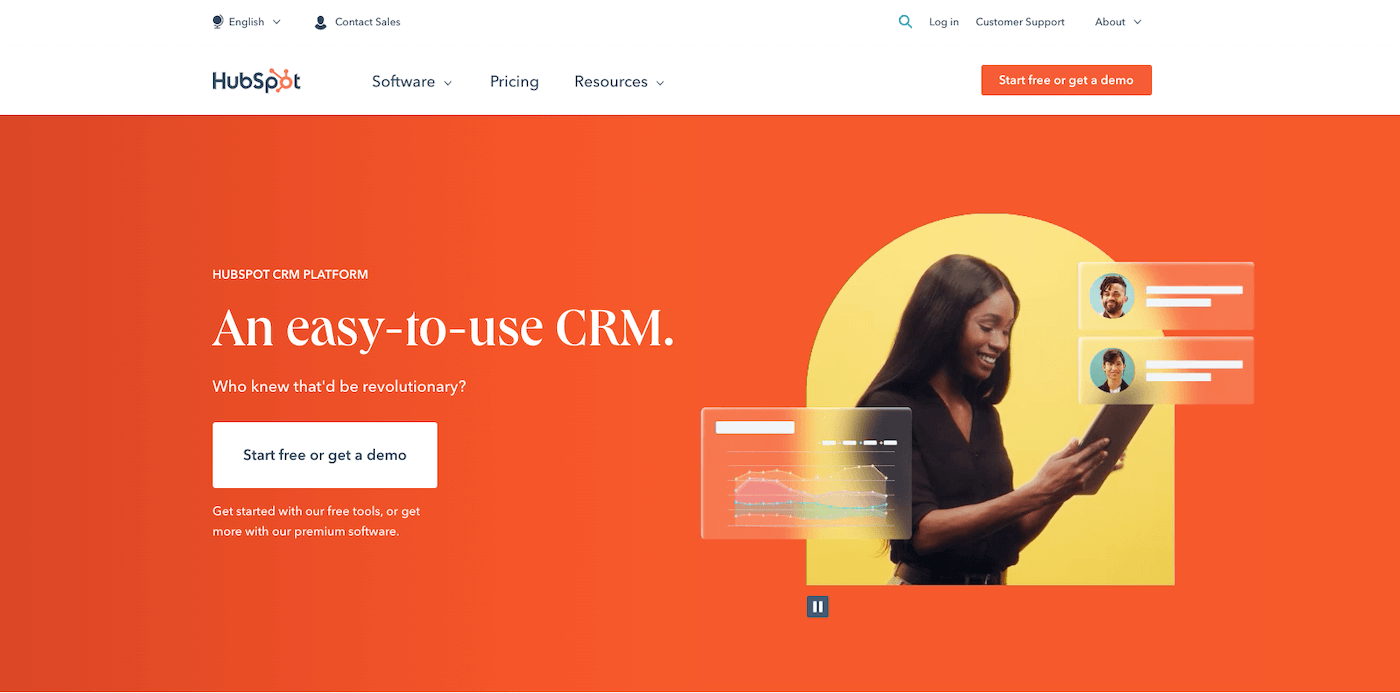 Where HubSpot beats Mailchimp:
Where HubSpot beats Mailchimp:
On the whole, HubSpot and Mailchimp both offer similar capabilities through their tools and features, however, HubSpot offers them on a much more comprehensive level. In terms of email automation, reports and analytics, HubSpot gives users access to a wider variety of automation features and a much more robust built-in CRM. If you’re looking for a solution to manage your email marketing, deals and contacts under one roof, HubSpot is our top choice.
Where Mailchimp wins:
Generally speaking, Mailchimp is cheaper than HubSpot, although it shares many of the same features and functionalities (see HubSpot’s pricing). If you are a smaller company, searching for an easy and reasonably-priced email marketing platform, Mailchimp is for you. Mailchimp provides a variety of features designed for small business owners to help grow your business in its early stages.
Try HubSpot for free
Mailjet
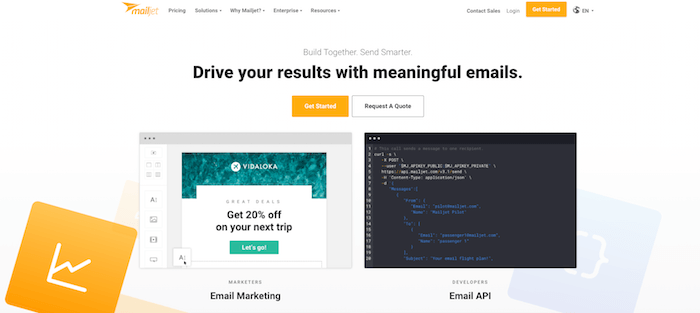
Mailjet, a French email service provider, is one of the more affordable email marketing tool on the market, making it a great Mailchimp alternative!
A neat feature is that the drag and drop email editor allows you to collaborate with other team members in real-time. This can make the design process much more agile and hopefully leads to a better campaign (so long as it doesn’t become a too many cooks situation).
Where Mailjet beats Mailchimp:
Making sure your emails are delivered to your subscribers is crucial, and Mailjet definitely has an edge over Mailchimp in this area. Our recent deliverability tests show that Mailjet takes this very seriously, keeping their scores up in the mid-nineties. This also makes them a great choice for sending transactional emails.
Another big plus for Mailjet is the price. Aside from offering a free plan with up to 200 emails per day and no contact limit, their paid plans are also some of the most affordable on the market. Mailjet’s Premium plan ($25/month) allows you to send up to 15,000 emails/month to unlimited contacts and benefit from all features, whereas Mailchimp’s Essentials plan (which has more or less the same features) will give you a limit of 1,500 contacts for roughly the same price ($20.99). See how Mailchimp and Mailjet compare in this side-by-side table.
Where Mailchimp wins:
It’s not necessarily where Mailchimp wins, but more where Mailjet slightly disappoints: the automations. These are limited to date-based and contact field conditions and are missing more behavioral triggers such as ‘has opened X email’ or ‘has clicked X link’. Of course, if you’re serious about automations then I’d recommend ActiveCampaign or GetResponse.
Try Mailjet for free
ConvertKit
Designed with digital marketers in mind, they are the (relatively) new kid on the block. ConvertKit claims to be all about transparency and they even make their financial situation available to everyone online. Since they first started in 2013, they’ve managed to get more than 35,000 subscribers. Which is not bad. Generally speaking, Mailchimp is a more mature and developed tool, but let’s check this in more detail to see if they make a good Mailchimp alternative.
Where ConvertKit beats Mailchimp:
Managing lists and contacts is more flexible, allowing you to create better-targeted email marketing campaigns. You can use a custom domain name for landing pages even on the free plan, which is a big plus. They also have responsive support, which can be an issue with Mailchimp.
> See how the tools compare in our ConvertKit vs Mailchimp guide.
Where Mailchimp wins:
ConvertKit only recently started offering a free plan. This limits you to 1,000 subscribers – Mailchimp’s is more generous. Mailchimp’s email and landing page editors are also really flexible – ConvertKit’s don’t even compare. With Mailchimp, you can create users for several team members, unfortunately, this is not available with ConvertKit. Reporting is also something Mailchimp does very well and ConvertKit not so well.
Try ConvertKit for free
Benchmark
Is Benchmark a good Mailchimp alternative? Focusing on international markets with a presence in 15 countries around the world, Benchmark’s paying plans place them in the middle-to-high end compared to other email marketing software. Unfortunately, their advanced features aren’t as impressive as others, but they are worth considering for their free and low price plans.
Where Benchmark beats Mailchimp:
They are a much better choice for multilingual teams. They also offer good support.
> See how Benchmark stacks up against Mailchimp in this side-by-side comparison.
Where Mailchimp wins:
As soon as you look at advanced features like reporting and automation, Benchmark ranks lower on our list. They also give you very limited amounts of image data storage – which is unlimited with Mailchimp. With a limit of only 250 emails/month, Benchmark’s free plan doesn’t compare to Mailchimp’s, which is far more generous.
Try Benchmark for free
AWeber
AWeber has been on the email marketing scene for over 20 years, just a few years more than Mailchimp. However, it was only recently that AWeber updated its service, which now includes a freemium plan.
The free plan, though it includes the same features as the paid plan, limits you to just 500 subscribers, which isn’t many at all, though you’ll be able to send them up to 3,000 emails/month – that’s 6 emails per subscriber per month.
Features include A/B testing, email analytics and conversion tracking. They also have various mobile apps, so you can send emails on-the-go.
Where AWeber beats Mailchimp:
AWeber’s list segmentation features help you keep your contacts organized. You can use their automations to automatically manage subscribers via the rules you create. They also have decent support and educational tools.
> See how the tools compare in our Aweber vs Mailchimp guide.
Where Mailchimp wins:
Mailchimp’s Freemium plan is much more generous than AWeber’s. However, once you get over 10,000 subscribers Mailchimp becomes slightly more expensive than AWeber. We’d recommend you check out MailerLite or Sendinblue for a cheaper Mailchimp alternative. See how AWeber compares to Mailchimp in this side-by-side comparison. Of all the alternatives to Mailchimp, AWeber might not be your no. 1 choice.
Try AWeber for free
Why we Don’t Recommend Constant Contact
Constant Contact is, seemingly, Mailchimp’s biggest competitor. It’s been around for almost three decades and owns the second-largest share of the email marketing market (5.08%) after Mailchimp (72.69%). However, with no free plan, high prices and a lack of advanced features, we really struggle to recommend Constant Contact against the competition.
You will find that the email marketing services listed above will provide much more value for money. And if you’d like to explore why further, you can check out our Constant Contact alternatives post.
We also have a detailed comparison of Mailchimp & Constant Contact that you may want to check out.
Free Mailchimp Alternatives
Most of the email marketing tools on the list offer a free version but of course, some are better than others.
MailerLite and Moosend have the most generous free email marketing plans, including 1,000 subscribers and 12,000 and unlimited emails respectively. What’s great is that you’ll have access to marketing automation, and in the case of Moosend, branding-free emails.
Sendinblue also offers a free version, but you’re limited to 300 emails/day, which isn’t ideal.
The best free email marketing service for ecommerce is Omnisend, which includes all pro features on the free version.
Though there are others, these are the best free Mailchimp alternatives, in our opinion.
Find out more about all the free email marketing services here.
Why Use Mailchimp?
Is there any reason that you should stick with Mailchimp? Despite its recent less-than-ideal changes, moving away from Mailchimp might not be the best move if:
You need detailed reporting:
Mailchimp has one of the most detailed reporting systems for tracking your newsletters’ performance, offering robust options such as Google Analytics integration, Geotracking, Social media and click maps.
You have a very small email list (and I mean really small!):
Mailchimp’s pricing model imposes new limits on their free plan. Now, your 2,000 contact limit includes all contacts, including unsubscribes and those who haven’t confirmed opt-in. If you know your total contact count will be less than this, then Mailchimp’s free plan is still pretty decent.
You want to easily design good looking emails:
Their drag and drop email builder is fast, simple and drag and drop. It’s very easy to create stunning emails that will stand out from the rest and engage your audience. They also have plenty of modern, well-designed email templates (though be aware that the templates available for free are very limited and not very modern-looking).
Who Should Look For Mailchimp Alternatives?
If you’re looking for a Mailchimp alternative, make a list of the reasons why, as these won’t be the same for everyone. We’ve analyzed the areas in which Mailchimp doesn’t do so well and listed a number of Mailchimp alternatives below.
You are on a tight budget:
As soon as you leave the freemium plan, things start to add up at MailChimp, especially now that they charge based on total number of contacts, rather than just subscribed contacts. Working out how much your email newsletter service will cost is not always straightforward. For instance, some will make you pay depending on the number of emails you send, others on your amount of subscribers. Luckily, we’ve created a handy cost calculator to help you get a clearer idea.
Cheaper Mailchimp alternatives: MailerLite, Sendinblue, Moosend, EngageBay or Mailjet
You need complex email marketing automation:
If you are really aiming to get the most from your email marketing campaigns, Mailchimp will appear slightly limited in terms of email marketing automation features. Their autoresponders are ok, but for campaigns based on user behavior (e.g. on your website), split tests and advanced workflows, you might want to look elsewhere.
Mailchimp alternatives for automations: ActiveCampaign, GetResponse
You want to manage multiple mailing lists:
Because Mailchimp keeps every contact list isolated from each other, it limits the amount of flexibility, creativity and precision you can have for your complex email marketing campaigns. For example, if user X belongs to 2 of your mailing lists, they will appear as subscribers twice. There is no good way to merge lists or create interdependencies between them.
Mailchimp alternatives for multiple lists: ActiveCampaign, Sendinblue, Omnisend
You want to set up dynamic landing pages and A/B test them:
Some email marketers do like to create special pages to send users once they click a certain link. These pages can offer tailored content and act as a powerful sales funnel or segmentation tool. Mailchimp’s landing pages are a bit basic, not offering A/B testing or personalized dynamic content.
Mailchimp alternatives for landing pages: GetResponse, ActiveCampaign, MailerLite, Omnisend
You need a robust yet affordable CRM software:
Collecting subscribers is one thing, but managing clients, companies and deals is quite another. As you probably know, things can get messy quickly if you don’t have a good sales and marketing tool to help you manage these processes, and keeping all your marketing and sales contacts in one place will save you a ton of time. Though Mailchimp claims to offer CRM features, these just scratch the surface, and no pipeline management features are included.
Mailchimp alternatives for CRM software: EngageBay, ActiveCampaign, Sendinblue, Zoho
You need strong data privacy:
Mailchimp isn’t the most data protection-conscious company. For example, a short while back they suddenly announced that they are about to deactivate the double opt-in feature for all customers. After an outcry from (mainly) EU-based customers, they retracted the change. Customers from Europe also usually prefer to have their data stored inside an EU country, which Mailchimp doesn’t offer.
Mailchimp alternatives: Sendinblue, MailerLite
Note: In September 2021, MailChimp was bought by financial software company Intuit for the sum of $12 billion. it is still unclear how this will affect the MailChimp product, however, the company’s shady history of lobbying certainly raises a red flag for us.
Mailchimp Alternatives: Conclusion
While Mailchimp was once the #1 choice when it came to a cost-effective email marketing service, a few recent pricing changes have made it a lot less affordable than it once was. There are alternatives to Mailchimp (even free ones) that will work perfectly well for you, it’s just a case of accessing what your email marketing needs are.
For users with small subscriber numbers who just want a simple and free solution, Mailchimp are one of the better platforms. However, now that you’re no longer able to schedule emails on the free plan, and the email templates begin to look very outdated, a free Mailchimp alternative may be a better choice.
If you want quality features with a smaller price tag, it’s worth investigating other companies such as MailerLite, Sendinblue or Moosend. They are all really good value-for-money email marketing platforms. Moosend is also the best Mailchimp alternative for pay-as-you-go users.
However, if you’re a power user, you should really look to ActiveCampaign or GetResponse if you want to create complex automations that react to the way your subscribers behave.
If you’re using Shopify, make sure to check out these Shopify email marketing tools.
Finally, if you also need a CRM, ActiveCampaign and Zoho are good options.
Hopefully, this overview has helped you save time in choosing your next solution! And don’t forget to add comments or questions if you need any more information.


